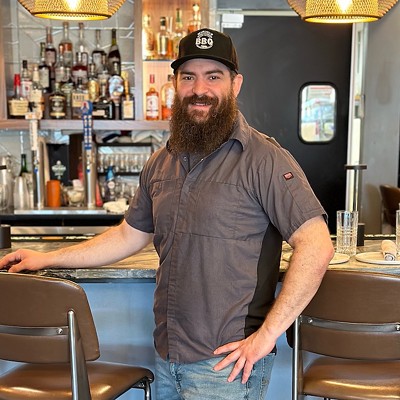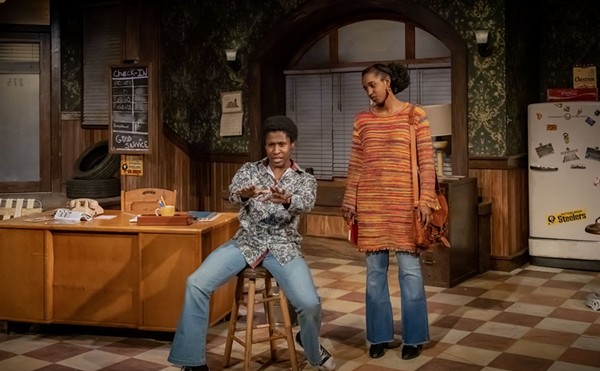Several years ago, in a discussion with my former employer on the subject of art, I was challenged with one simple question: "Why is it important?" That question has permeated my decision-making process in the studio and in writing reviews for this fine rag. As we traveled to the current alumni shows by Joe Bartram and Mike Gable in the Emily Davis Gallery at the University of Akron's Myers School of Art, that question dogged me once again.
Alumni (and faculty) shows at art schools are tools of thought, process and the power of follow through. These visual theses are host to dialogue between the professor and student. This is especially poignant during portfolio days, and on this particular day the school was having theirs. Portfolio review is a time when hundreds of hopeful high school students and other motivated individuals bring in samples of their work and talk about it with educators and admissions personnel. It was a wonderful spectacle to behold.
In the hallways and atrium hangs student work. Professor Matthew Kolodziej and his students "explore ideas related to corporate and political bodies." Again, hosting dialogue, is a challenge by Matt Kenyon, new media sculptor and director of the art practice S.W.A.M.P. (Studies of Work Atmosphere and Mass Production), who exhibited last month at Emily Davis Gallery. He notes, "There is room here for looking at biomimicry as it relates to corporate form and function in the world." The student response is impressive and we look forward to watching the career trajectory of some of these young minds.
Passing through the crowd, we entered the gallery and began on the lower level with Joe Bartram's solo exhibition titled Bassacabeza, which stemmed from a discussion on cabeza (head meat) tacos and ultimately led to pushing the idea through stereo sound experimentation in the studio. Bartram has taken imprints from industrial sites to wet canvases and has manipulated them with myriad unusual materials. In the end we are left with a series of work that can't quite be described as painting, but rather square ghosts of time.
Using bleach, dye and household cleaners, as well as gold and silver leaf, the pieces makes it hard to determine which takes place first: the building up of the work or its deconstruction. Together, the nine artworks that line the wall tell a minimalist story about our environments. They are also beautiful objects on their own with an almost hypnotic effect in their minimalism.
Not all the works in Bassacabeza are two-dimensional, however. "Triple Crystal MK.2," constructed of bronze, steel and ceramic, reminds us of personages congregating toward or away from the icons on either side. "The Gully," a striking sculpture made of cardboard, wood, steel, tar and asphalt, stands firm as an onyx-hued archway. Perhaps it is the throat of wealth and corruption that holds our country captive to dinosaur ideas led by dinosaur industries. Ultimately, Bartram's exhibition is not simply a show of paintings and sculpture, but a full installation of responses to the questions of industry and urban landscape.
Moving to the upper gallery, we can taste the "casual anxiety" that Mike Gable serves us in his solo show titled Special Interest. The mood of this exhibition is different in scale as well as medium.
Gable creates paintings about painting and other source material. With pthalo greens, aquamarines, pinks, yellows and blues, we are swimming in a pool of dreamy atmospheres that dip, perhaps, into religion, health care and consumerism.
"Jesus Wax," an artwork made through mixed media and oil on canvas, suggests a journey through the desert with its azure sky and sand floor. Through layers of paint and graphite, we feel like we are reading from a page in Gable's personal diary of brushstrokes and mark making. "Good for Gout," a wonderful small work, creates a tableau with fake, ruby red cherries (long held as a great band-aid throughout a gout bout) before a blue-ish background painted on weathered, gray cardboard. Another cheeky piece is "Off Ramp." In this instance, we see a sexy, stark yellow McDonald's sign high above the earth, beckoning us to quit being voyeurs, to pull off the freeway and join the masses, only to regret it later.
Bartram and Gable invite us into their hard examinations through their respective visual lexicons. In other words, they make us think. We look forward to how the students and the public dialogue with their work. And that is important.












